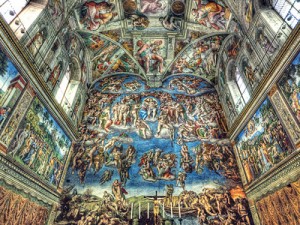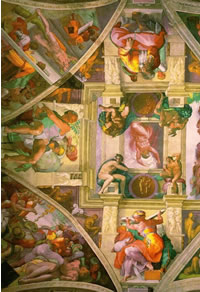The ceiling of the Sistine Chapel in the Apostolic Palace of the Vatican is widely recognised as one of the great triumphs in human artistic endeavour. Painted from 1508 to 1512, Michelangelo’s striking portrayal of the creation, fall and destruction of humankind by the flood has evoked enormous praise for its interpretative and creative genius. As one commentator puts it, “rarely has anyone so beautifully depicted the human form. Never has the scope of the divine and human drama been so powerfully portrayed.”
How sad then, that Michelangelo masterpiece began to degrade almost immediately. No sooner had his scaffolding bridge, on which he had stood and lain to paint, been removed than the combination of smoke and grime, ever present in the chapel, began to attack the hue, lightness and colour of his work. Such was the damage inflicted by these unrecognised art terrorists that within a century of its completion, no-one even remembered what Michelangelo’s original frescoes had really looked like.
In subsequent centuries, well-intentioned restorers tried to deal with the problem by covering over the work with a type of varnish in a short-lived attempt to revitalize the original colours but that only served as an adhesive for yet more smoke and dirt. The painter Biagio Biagetti wrote in 1936, “We see the colours of the Sistine ceiling as if through smoked glass.”
However, In 1981, while cleaning other priceless frescoes within the chapel, Fabrizio Mancinelli, director of restoration work, performed a critical experiment on the smoked glass masterpiece. At the top of the scaffolding being used to clean the other frescoes, Mancinelli was able to reach Michelangelo’s lunette of Mathan and Eleazer, ancesters of Christ and using a special solution called AB-57 cleaned a minute portion of the famous painting.
The results were excellent and the decision was taken to clean the entire lunette – but only one sq
uare inch at a time! After all, this was the work of Michelangelo. Art experts from the Vatican and all around Italy were invited to view the results and, based on their conclusions, plans for the most ambitious restoration project in art history were set in place. They would restore the entire ceiling of the Sistine Chapel!
A six-yard-wide bridge was built for the project and attached in the same holes used for Michelangelo’s bridge and the restoration advanced slowly and carefully, inch by precious inch. Various different approaches were needed throughout the process. For example, on portions were Michelangelo had painted on dry plaster, a different technique and solution was needed to those places where he’d painted on wet plaster.
The task was completed on December 31st 1989. It had taken twice as long to clean the ceiling as the artist had needed to paint the original. But the result was breathtaking. Beneath the centuries of smoke and grime, and beneath the flawed attempts to protect what was under the surface, lay vibrant detail and wonderful colour never before realised by students of the great master painter.
Michelangelo had been known as a master of form—his frescoes had been said to resemble sculpture rather than painting, but following the restoration work now completed, suddenly he was revealed as a master also of colour—with azure, malachite green, rose and lavender of such nuance that experts could only gaze in amazement.
Not surprisingly, there was quite a bit of controversy over the restoration. Many critics said no restoration was necessary. Some protested that the process had actually destroyed the work. But most agreed on two things: for the first time in nearly five hundred years, people were viewing this masterpiece the way it was originally intended; and secondly, before the

restoration no-one could have imagined just how wonderful Michelangelo’s original creation had actually been.
Without wanting to be overly dramatic (I am a Presbyterian after all!!), it is my firm conviction that the reason we need to be working through and understanding the sort of issues we have been looking at in our little blog series thus far – such as legalism, individualism, Platonism etc – is that for most of us our view of the gospel has undergone a similar degrading to that of Michelangelo’s work on that chapel ceiling.
For hundreds of years now, perceived and unperceived theological and cultural terrorists have been at work in our midst undermining, discolouring and degrading the glorious wonder of the Gospel of Jesus Christ. And such has been the enduring effectiveness of this attack that few of us in the church today even remember what the hue, light and colour of that original masterpiece actually was. If this is so for us then it is doubly so for those outside of the church. Despite what is taken for granted in so much of modern secular and sacred literature, the vast majority of church and non-church going men and women in our country have not actually cooled in devotion or rejected Christianity at all. They have simply never comprehended it and thus have never had the chance to decide what their response will be.
One of the things that excites me most about following Jesus, is that every time we peel off another layer of what his message has been coated in over the years, what we discover underneath is not a diminished nor reduced Gospel but rather the opposite. The more we understand the truth about what Jesus taught and accomplished, the more we see the wonder of his life, death, resurrection and ascension. The more we see that wonder, the more captivated and amazed we become. (It is for this reason that in the end, like the role of Gollum in the Lord of the Rings, the seeming opposition to our faith from people like Darwin, Nietzsche, Bultmann, and Dawkins et al may well prove to have been gift as well as burden. But we’ll leave that for another day!)
So now that we’ve looked at some of the things that shouldn’t be in the Gospel let’s begin to remind ourselves of what should be.

